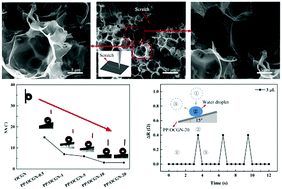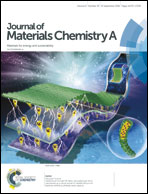A self-sensing, superhydrophobic, heterogeneous graphene network with controllable adhesion behavior†
Abstract
Smart superhydrophobic surfaces with controllable adhesion behavior or sensing capability have become a research hotspot in many areas, such as self-cleaning and microdroplet transportation. Herein, we design and fabricate a superhydrophobic, open-cell graphene network with a polypropylene coating (PP/OCGN) via a new method of boiling coating. The adhesive force of PP/OCGN for water droplets can be controlled easily from 66.8 μN to 32.3 μN by adjusting the soaking time. Using the PP/OCGN with controllable adhesion behavior, the lossless transportation of water microdroplets has been achieved. What's more, because of the boiling coating process, the PP/OCGN exhibits a heterogeneous network, which has the coated graphene on the surface and the uncoated graphene in the inner part. By means of the special network and strong water repellency of PP/OCGN, we report for the first time a conductive, superhydrophobic graphene material with a self-sensing capability for continuously falling water droplets. When the water droplets fall on the surface, the PP/OCGN with low adhesive force not only makes the droplets bounce off successfully, but also has a rapid response to the bouncing process through changing the resistance. The size of falling water droplets can also be determined. Therefore, our multifunctional superhydrophobic PP/OCGN can meet multiple needs simultaneously, such as self-cleaning and detecting raindrops, and it has great application prospects in the future.

- This article is part of the themed collection: 2018 Journal of Materials Chemistry A HOT Papers


 Please wait while we load your content...
Please wait while we load your content...